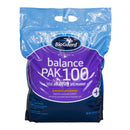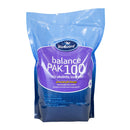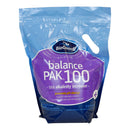Description
BioGuard Balance Pak 100 is used to raise total alkalinity. Maintaining proper total alkalinity prevents pH from bouncing due to rain, bather load, and other chemical applications. Low alkalinity may also cause pool water to be corrosive to the metal and plastic with which it comes in contact. This product is proven to help prevent pool staining, plaster etching or liner wrinkling. The contents of Balance Pak 100 dissolve quickly when added directly to water. Max Dose 4lbs per 10,000 gal. every 2 to 4 hours.
Ideal Total Alkalinity Range for Pools: 120-150 ppm Some pools 80-120 ppm
Testing Pool Alkalinity: Test your pools alkalinity level at least twice per week, with a test kit or strips. We also recommend taking a water sample to a dealer test station periodically (once per month) to verify results.
What is Total Alkalinity?
Total Alkalinity describes how “buffered” the water is against sudden changes in your pools pH, or how the pool water resist pH change. The alkalinity of your pool is perhaps the most important water balancing step in your pool to manage and should always be the first thing you test before adding chemicals into the pool. The ideal range for your pools alkalinity level should be between 120-150 ppm (parts per million).
Note:You can have technically balanced pool water, as measured by the Langelier Saturation Index (LSI), even if your total alkalinity levels may be a little high or low.
Low Total Alkalinity
Just as low pH and low calcium hardness levels can be damaging to your pool, so can having a low total alkalinity level. While a low alkalinity level may not immediately be noticeable on pool equipment and surfaces, a low alkalinity level will often drive the pH level in the pool down, turning the pool water more acidic, resulting in itchy dry skin and irritated eyes. Additional problems associated with a low total alkalinity level in pools include:
- Pitting, etching, cracking and delaminating of pool walls and surfaces
- Corrosion of metal surfaces in or around your pool (i.e. filters, screws, pipes, etc.), which can also result in stained pool walls
- Pool sanitizers (i.e. chlorine and bromine) are less effective, so to achieve the same sanitizing effect you’ll need to add more
- pH bounce (when a pools pH level quickly fluctuates up and down
How to Raise Alkalinity in a Pool
Before you begin to adjust the total alkalinity in the swimming pool, be sure you know how large your pool is (gallons) and what your target range is. You ideally want to be in the middle of the range between 120-150 ppm.
Use an Alkalinity Increaser like Balance PAK100 to increase your swimming pools alkalinity level: sodium bicarbonate (baking soda) or any type of alkalinity increaser product. After adding the alkalinity increaser, let the pool sit for at least 4 - 6 hours before retesting.
High Total Alkalinity
While high alkalinity levels are not as damaging to your pool as low alkalinity levels, it’s still important to keep the total alkalinity balanced to prevent against unplanned maintenance costs and prolong the life of your pool pump, filter, pipes and other equipment. The most common problem pool owners experience with high alkalinity levels is cloudy/ murky water, as pool water with high alkalinity allows for particles to more easily come out of solution (i.e. substances float freely in the water). It is from this dissolution of water that many of the other pool issues associated with high alkalinity stem, including:
- Water scaling on pool surfaces and equipment
- Reduced water circulation due to clogged pipes and filters as particles come out of solution, floating freely in the water and are deposited on things the pool water comes in contact with (i.e. scaling)
- Clogged filters
- Higher water pressure, as pumps become clogged and pipes narrow with scale they are forced to run harder, resulting in cracks and reducing the lifespan of your pool pump
- pH lock, where changes to the pool water’s pH are resisted due to the high alkaline level in the pool
How to Lower Alkalinity in a Pool
The two most popular chemicals available to help you lower the total alkalinity in your swimming pool are muriatic acid and sodium bisulfate (also known as dry acid LO & SLO). After you’ve added muriatic acid, dry acid or another alkalinity decreaser product be sure to check the pH level in the pool, as the pH level may have dropped as well.
Payment & Security
Your payment information is processed securely. We do not store credit card details nor have access to your credit card information.







